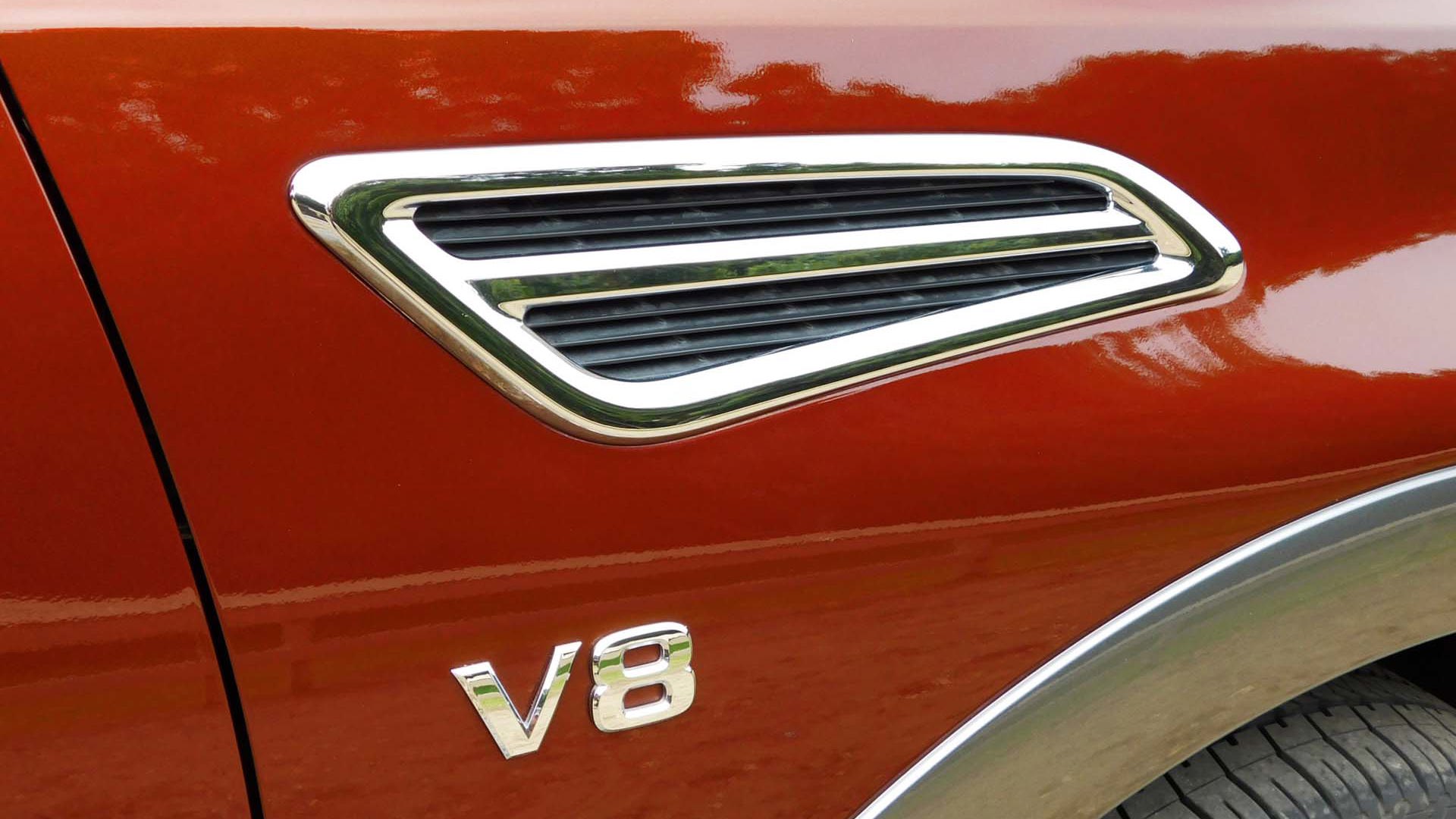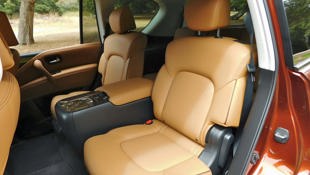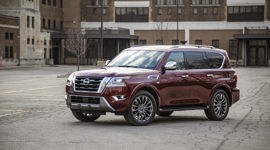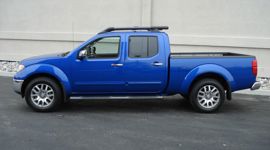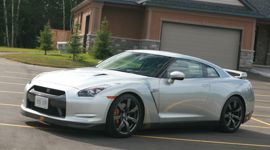After taking a hiatus for 2016, Nissan's full-size Armada SUV is back for 2017 in all-new form. It's not quite the same Armada North Americans have grown accustomed to, however: Where the previous Armada was based on the Titan pick-up truck and built in Canton, Mississippi, the new Armada makes a clean break from the Titan and is instead built in Japan based on the global Patrol platform, same as the luxury-oriented Infiniti QX80. Nissan could equally well have decided to align the naming convention and ditch the Armada nameplate here in favour of Patrol, but either way it's a capable SUV that's well-respected worldwide.
The new Armada makes a clean break from the Titan and is instead built in Japan based on the global Patrol platform, same as the luxury-oriented Infiniti QX80.
The all-new North American market Patrol – Armada, that is – was revealed at the 2016 Chicago Auto Show, and journalists were given an opportunity to drive it recently both on the road and off-road in sunny northern California.
The Patrol traces its roots back to 1951 model year, when it was introduced as a competitor to the Toyota Land Cruiser. Now in its sixth generation (which has been around since 2010), it features stout body-on-frame construction, four-wheel-drive underpinnings, and three-row seating for up to eight passengers.
Styling-wise the North American Armada cleaves very closely to the global Patrol on which it's based (unlike the related Infiniti QX80, which sports a bulbously overstyled front end and enough blingy details for several SUVs). The bumpers and parts of the frame have been modified from the global platform to meet North American standards, but the overall look remains the same. Up front, there's the familial Nissan V-motion grille, with standard LED headlights and taillights, and distinctive boomerang LED character lighting. The basic shape is upright and sturdy, as befits a big SUV, and the overall effect is handsome and purposeful (even the enormous fender ports are apparently functional, if a little unsubtle). In terms of size it's a fraction longer overall than the previous Armada (30 mm longer) but rides on a slightly shorter wheelbase (53 mm shorter). From a practical standpoint, the upright, no-nonsense styling means that the Armada has big windows and very good outward visibility for such a large vehicle.
Under the hood, the 2017 Armada gets a new version of Nissan's 5.6L Endurance V8 engine, the same as used in the new 2017 Titan. The engine was developed specifically for North American requirements and is built in Decherd, Tennessee then shipped to Japan for installation on the Armada assembly line. It develops 390 hp at 5,800 rpm and 394 lb-ft of torque at 4,000 rpm, with direct injection and improved heat management systems allowing both more power and better fuel economy than the previous V8. At idle it's smooth and quiet, and under hard acceleration it offers a pleasing deep bellow.
While official fuel consumption numbers aren't yet available, Nissan's engineers indicated that fuel consumption for the Armada should be better than the current QX80, which rates 17.4 / 12.2 L/100 km city/highway. As well, the Armada is tuned to run on regular fuel, versus the QX80 which requires premium. During our mixed test driving we saw about 13.6 US mpg, which works out to 17.3 L/100 km, but that included a lot of idling while taking photos. Unlike in the Titan, there are no plans to offer a diesel in the Armada.
Epic Spec Battle: 2017 Nissan Armada vs. 1588 Spanish Armada
The engine is hooked up to an all-new seven-speed transmission (in place of the previous five-speed) with adaptive shift control and downshift rev-matching. The transmission is designed to provide a wide range between its low ratio and high ratio gears, and is well-matched to the engine. During the test drive it scored high points, with crisp shifts and quick responses in manual mode.
Underpinning the 2017 Armada is a fully-independent suspension with double wishbones front and rear, twin-tube shock absorbers at each corner, and hydraulically-assisted rack-and-pinion steering. Braking duties are taken care of by powerful four-wheel antilock disc brakes. Tire sizes are a sensible and off-road capable 275/60R20 regardless of trim – no ridiculously vulnerable 22-inch 50-series bling rims here, thanks very much. On the road the suspension provides a very comfortable ride and decent handling, although it felt a little floaty over some road surfaces. The traditional hydraulic power steering offers nice feedback, and overall for such a big SUV the Armada is remarkably athletic-feeling and pleasant to drive on the road.
We also got a chance to venture off-road, and here the Armada is thoroughly capable. North American versions lack some of the hardcore off-road features of their global cousins (there's no locking rear diff or hill descent control, for instance) but the Armada does get proper four-wheel low-range gearing, with an electronically controlled two-speed transfer case offering Auto, 4H (high) and 4L (low) modes, and limited slip functionality thanks to Nissan's ABLS (active brake limited slip) system. On the challenging test course – which featured steep hills with extreme angles of approach and departure, wickedly angled side slopes, and "elephant track" offset hummocks that had two wheels off the ground at times – the Armada powered confidently through it all with minimal fuss, drama, or wheelspin, and with the 4L mode providing enough engine braking that hill descent control wasn't missed. Back on the road, Auto mode will operate in 2WD when conditions allow in order to maximize fuel economy.
Most large SUVs are sold as family-haulers so it's inside where things really count, and here the Armada scores well. While U.S. buyers will have a choice of SV, SL or Platinum trim, Canadians get only SL and Platinum, with supple leather-upholstered seating for up to eight, or seven if you choose the second-row captain’s chairs available in Platinum trim. The front and second-row seats are comfortable and properly spacious – indeed quite limo-like in the second row – while the third row has decent access but is a less comfortable place to sit, with limited foot room and low seat squabs that leave longer-legged passengers with their knees sticking up. All seats have recline functionality, with power recline and folding for the third row (this latter feature is convenient, but annoyingly slow). There's a reasonable 550 litres of cargo space behind the third-row seats, and 1,490 litres of space with the third row folded (it folds nice and flat too). With all seats folded you get 3,100 litres of space. In terms of in-cabin storage there's an ample console storage bin and all the expected cupholders and cubbies.
Interior creature comforts include a stitched soft-top dash and door uppers, standard power lumbar support up front, standard heated front seats and steering wheel, dual-zone automatic climate control, and acoustic glass to provide an exceptionally quiet driving environment. At idle the noise level is on par with a library, and at 100 km/h it rises only to about the level of quiet conversation (63 db on my highly calibrated free smartphone app, compared to about 70 db in competing vehicles). In general the interior feels much more "luxury" than "mainstream", and about my only quibble is that the glossy woodgrain trim isn't quite my cup of tea.
In terms of technology, the 2017 Nissan Armada includes a standard GPS navigation system, 13-speaker Bose sound system, around-view monitor with moving object detection, blind spot monitor, front and rear sonar with backup collision intervention, forward emergency braking with predictive forward collision warning, distance control assist, pushbutton start, and more. Step up to the Platinum trim and you get a family entertainment system, lane departure warning and prevention, blind spot intervention, and speed-sensitive power steering. The infotainment interface doesn't appear to be Nissan's latest-generation system, but it's reasonably straightforward and intuitive to use. My one complaint is that there's only one USB port, but Nissan's marketing people said to "stay tuned" on this, and meanwhile there are several 12V outlets to take care of charging needs, provided you bring along appropriate USB charging adaptors.
Priced starting at $63,498, and with the Platinum trim coming in at $69,998, the Nissan Armada competes against mainstream large SUVs including the Chevrolet Tahoe, GMC Yukon, Ford Expedition and Toyota Sequoia. In fully-loaded Platinum guise, it also perhaps competes against its Infiniti QX80 cousin. Where it has an edge over the competition is its best-in-class 3,856 kg (8,500 lb) towing capacity, very well appointed interior, and limo-like second-row seats. For families who want to be able to haul themselves and their toys in exceptional comfort it should definitely be on the shortlist of considerations. It will be available in dealerships starting in mid-August 2017.















